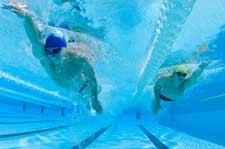Then talented, motivated, well-prepared athletes start achieving faster-than-predicated times, the venue in which it happens develops a reputation as a “fast” pool. Many view this term with skepticism. A cynical swimming coach might even say, “If you want a fast pool, invite fast swimmers.” Still, watch any major swimming event and you’ll often hear swimmers, coaches and announcers praising the pool as if it had a magical part in the record-breaking performances. The truth is, it’s not magic at all, but rather science, very complicated science. In the pool that means cool, clear, turbulent-free water equipped with long, stable, slip-resistant starting blocks and properly tensioned, wave-quelling lane dividers. Outside, it means chloramine-free air, a well-lit environment coupled with the energy that comes from several hundred screaming fans, coaches and teammates.
Fast pool or not, most coaches agree that the swimmer really deserves the credit. When an athlete such as Michael Phelps comes along with the ability to crush records (usually his own) with the frequency of the postman, record swims can and do happen in average pools. But anyone involved in competitive swimming long enough will tell you that the pool definitely can influence performance. The design of such a pool requires understanding of intricate interactions between swimmers and their aquatic environments.
Here’s a look at five elements that can make or break a fast pool.
1 Smooth surface. Imagine paddling a canoe across a choppy, windswept lake; the surface waves can certainly make paddling difficult. Similarly, in an outdoor competition pool, wind can produce waves that negatively affect a swimmer’s progress.
Waves also are generated by the other swimmers; even swimmers’ own waves impede progress every time they make a turn and must return directly into the waves just produced. A pool that effectively absorbs waves offers athletes the best opportunity to swim their fastest. Consequently, an 18-inch to 24-inch-deep gutter is preferred because even the smallest ripple that flows into the gutter is absorbed without rebound. This gutter design provides visual reference above the surface, which helps competitors accurately judge their location relative to the turning surface.
Touchpad design also is fundamental to wave control. These are the components of the timing system that mount on the end of pool walls and sense the swimmer’s touch to stop the clock. FINA (one of the sport’s governing bodies) requires the pads to extend 30 centimeters above the water surface. Such pads have been shown to inhibit the gutter’s ability to absorb bow wave energy, thus resulting in choppy conditions and a slower racecourse. Conversely, the gutter hung touchpads used primarily in the United States do not disrupt the gutter’s ability to absorb wave energy.
Well-designed and properly tensioned floating lane lines are vital to keeping the swimmer’s waves isolated in one lane, while smoothing out the water within that lane. The role of the lane line is extremely important in relay events because the lead swimmers produce significant waves when they dive into the pool adjacent to incoming swimmers.
2 Turbulent-free subsurface. Movement of the water below the surface can have a negative influence on a competitive swimmer. In competition pool recirculation systems, water is returned to the pool after treatment through an inlet system located in the pool walls or the floor.
If a pool has a recirculation system that is not designed or located to reduce subsurface currents, a swimmer must pass through water with crosscurrents. This can negatively affect the swimmer’s catch of the water as well as increase frictional forces. The inlet and outlet systems should be adjustable and located/designed to minimize subsurface turbulence.
3 Pool depth. Coaches and athletes widely believe that in a shallow pool, “pressure waves” bounce off the bottom and can interfere with a swimmer’s progress. In actuality because pressure waves (aka sound waves) travel at 4,700 feet per second through water, they reflect back to the swimmer almost instantly, at any pool depth.
It is friction that really makes water depth a key contributor to a fast pool. When a swimmer moves through the water, friction causes some of the pool water to travel along with the swimmer. In this “boundary layer,” water close to the swimmer travels at approximately the same speed as the swimmer. At greater distances from the swimmer, water is pulled along at exponentially slower speeds.
If this boundary layer comes in contact with a stationary surface (such as the pool floor), that surface can actually slow the swimmer. You may have felt the “bump” from a passing truck’s boundary layer while seated in your car. What you probably did not realize was that your presence actually slowed the truck!
Twenty years ago, swimmers stayed near the surface nearly their entire race. Today most elite competitors swim a large percentage of their races 3 to 4 feet below the surface, utilizing a butterfly (dolphin) kicking technique. This technique has been shown to create turbulence that extends far beyond the boundary layer produced in other strokes. In a shallow pool, swimmers utilizing this technique will face higher drag forces and may even have to modify their technique. Because of these factors, pool depth more closely correlates to swimming speed today than in the past. Many believe the FINA Olympic standard of 2 meters (6 feet, 7 inches) is the minimum depth required; however, many of the world’s top competition facilities are 10 feet or deeper.
4 Predictability(race precision). Unlike golf, where no two courses, holes or strokes are the same, fast swimming requires consistency and predictability. Many coaches think championship meets should be held only in indoor facilities due to Mother Nature’s tendency to be unpredictable. Lane markings, backstroke flag locations and starting block height are standardized according to the rule book of the event’s governing bodies (USA Swimming, FINA, NCAA).
A swimmer’s ability to see pool wall targets, floor markings and the other swimmers is critically related to race precision. Good visibility depends upon water clarity, state-of-the-art filtration and chemical treatment systems, as well as lighting levels. One hundred foot-candles of light is recommended for competitive events, more if televised. All surfaces touched by the swimmer, such as walls and starting blocks, should have slip resistant surfaces to promote race precision.
5 Physiological factors. Humans are sensitive to very slight variations in temperature and have a small range of tolerance when leading to peak performances. Water that’s too cold causes muscles to tighten, while too-warm water causes overheating and lethargy. Water temperature at 79-81 degrees F is ideal for competition.
Swimmers’ ability to perform at their best also is related to their ability to extract oxygen from the air. Well-designed pool water-treatment systems and natatorium air handling systems help ensure high quality air to maximize an athlete’s respiration potential.
So why aren’t all new competitive pools built to be fast? It really depends on how the pool will be used. In the planning phase, certain questions should be asked by the designer: Will the pool host meets? What type of meets? How many teams? How many spectators? Will the pool host championship events? Are there other championship level facilities within the vicinity?
Significant trade-offs occur when considering a championship-type pool facility and, more than likely, budget constraints will prevail. Many lap pools are well-suited for daily swim team usage, but lack the additional space for spectator and deckside seating necessary for hosting meets.
USA Swimming does not specify, but recommends, a minimum of 400 seats for USA Swim Invitational meets; a minimum of 600 seats for USA Swim LSC Championships or Sectional meets; and a minimum of 1,000 seats for USA Swim National caliber meets. Specifications are limited to recommendations simply because some areas hold outdoor meets and can bring in temporary seating. Large, world-class meets recently have been staged with temporary pools with seating for 10,000 or more. Due to the spectator and deck seating requirements for a championship facility, the square footage of such a facility (and therefore cost) is greatly increased.
Other considerations include lighting, scoreboards and acoustics. While 100 foot-candles of light is recommended for competition, significantly lower levels are appropriate for recreation, instruction and even swim training. Depending upon the level of the meet, a scoreboard that displays swimmers’ names, lanes, times and other relative information is expected. The cost for such equipment can range from $10,000 for a simple line display to $150,000 or more for a large, full-color video display.
What’s more, the interior surfaces of a natatorium consist of water, masonry, concrete, tile, metal and glass. All have high sound reflection characteristics. With a championship meet facility, it is critical that high-end acoustical treatments be applied so the PA system can be heard clearly over splashing, diving board reverberation and shouting.
Championship pool depth will impede many instructional, fitness and recreational opportunities — and revenue potential. Movable floors or other means of altering water depth can be provided; however, the cost of such floor systems often is considered prohibitive. In addition, a competitive gutter system designed to give athletes visual reference above the water surface for accurate, quick turns makes the pool difficult for other users to enter and exit.
Further, 80-degree water, ideal for training and competitive events, is unsuitable for many instructional and recreational activities, which prefer an 84-87 degree F range. For these reasons, many competitive swimming facilities are benefiting from the revenue generation potential of other types of pools within the same facility. Finally, one must be aware that there may be other championship facilities in the area that will be competing to host a limited number of championship events.
Ultimately, competitive pools should be designed with many considerations and not always to result in the fastest possible swims. Elite athletes and coaches invest hundreds of hours toward goals as modest as a personal best or as lofty as an Olympic gold. Achievement of these goals are generally only expected at championship meet scenarios following a well-planned season and taper. It is these occasions when swimmers deserve to compete in a pool that optimizes their chances of meeting their goals. When successful, goals are met, expectations are exceeded, and a reputation as a fast pool is built.



